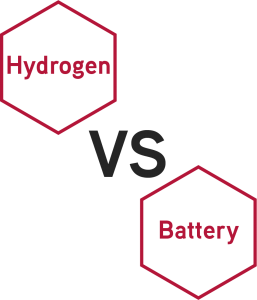


Bethan Roullier
Head of BD Grants
The Road to Zero
The UK automotive industry has a primary focus on lowering carbon emissions. The Road to Zero Strategy outlines the UK’s plans to massively expand the green infrastructure across the country, reduce emissions from the vehicles already on the road, and push along the uptake of zero emission vehicles.
The two options with zero tailpipe emissions currently on the market are hydrogen-powered electric vehicles and battery-powered electric vehicles. While they are both fully electric vehicles (EV’s), there are some major differences with what happens under the bonnet!
Hydrogen power
Toyota and Hyundai are already producing hydrogen powered vehicles to buy.
These vehicles are powered by hydrogen fuel cells, which work by splitting hydrogen atoms, the lightest atom in existence. This reaction produces electrons, which provide the electricity needed to power the vehicle, and protons which are mixed with oxygen to create water as a harmless by-product, the only emission from the exhaust!
The huge benefit of hydrogen vehicles is that they produce a large range of around 400 miles. When compared to battery powered EV’s, this can be up to 3-times the range. They are also quickly refuelled – around 3 minutes to refill the tank!
However, despite hydrogen being the most abundant element in the universe, it isn’t commonly found in a pure form on Earth – instead contained mostly in water – and infrastructure for hydrogen fuel production is required to support the large-scale use of hydrogen vehicles.
Whilst, these processes such as electrolysis can be powered from renewable energy sources, and can produce fuel onsite removing the need to transport fuel as we do now, there is currently no such infrastructure in place in the UK.
With very few re-fuelling points available, how would you cope, and would it stop you purchasing one?

Battery power
Numerous battery EV’s already exist on the market, from small city cars such as the Renault Zoe), small hatchbacks (BMW i3, Nissan Leaf) to SUVs (Tesla Model X, Jaguar I-pace)
These vehicles Battery EV’s are powered directly by electricity stored within a battery, with approximately 42,000 times more power than your television remote. These batteries currently almost all use Lithium-ion technology, which can offer a range of around 250 miles.
Battery EV’s are currently the most popular ‘green’ option, with ownership increasing year-on-year, helped by a rapidly growing UK charging infrastructure which already has 14,000 public charging points, with many people also having the option to charge their vehicle at home or work.
Despite taking a relatively long time to charge, lots of exciting opportunities also exist for integration with smart electricity networks, such as vehicle-to-grid technology which can also use the energy stored in EV batteries to also supply electricity to homes when not in use!
However, the high-capacity Lithium-ion batteries use large quantities of rare earth metals, and whilst there are no carbon emissions coming from the exhaust, most of the grid-electricity we use in the UK is produced by power plants which do not use renewable energy.
The question over how close to zero emissions we can get with EVs therefore still persists – or are thinking of getting, or already own, an EV, and what do you think about them overall?
Where next?
Both technologies have their pro’s and con’s, and neither can currently cut overall emissions to zero, as the ‘fuel’ they need is not yet produced in sufficient amounts from renewable energy supplies.
Indeed, it is too early to say which route on the Road to Zero will prevail, or ultimately whether both can exist side by side as widely used zero-emission technologies in the future.
However, what we do know is that the time to move these technologies from the fringes to the mainstream is now.
Recognising this, the UK aims to become a world leader in the zero-emission revolution, and the government is investing a huge amount of funding for R&D into the core vehicle technologies, how to increase the range, as well as the ‘re-fuelling’ infrastructure.
This strategy – reflecting the funding opportunities we are seeing – has enabled the everchanging UK automotive industry to reach critical mass in this sector, which is always seeking to produce new and exciting innovations to get the UK to the zero-emission targets set for 2030!
We at TBAT are excited to see what the future brings, and to be part of this journey.
Is your business developing infrastructure or technology that could support either of these vehicle types?
Do you need funding for further develop them?
If the answer to those questions is YES, get in touch with TBAT today to discuss the variety of funding options available for automotive businesses, throughout the R&D life-cycle.
Take a look at our monthly Grant Funding update, highlighting some of the key funding calls available, supporting research, development and innovation.

Take a look at our monthly Grant Funding update, highlighting some of the key funding calls available, supporting research, development and innovation.

Assists organisations in accessing research and development grant funding across a range of UK and EU schemes and industry sectors.
Get In Touch